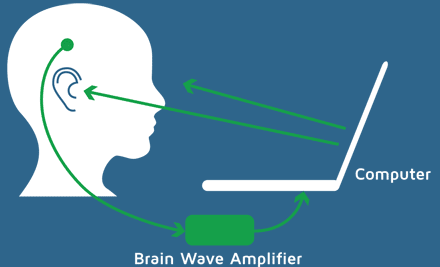Neurofeedback Loop

How does it work?
- Electrodes measure brainwave activity (EEG)*
- Amplifier reads and sorts the EEG signal
- Software translates to audio/visual feedback
- Individualized “protocols” guide the brain to increase and decrease amplitudes of different frequencies
- The brain learns to repeat targeted EEG patterns (operant conditioning)
* Neurofeedback is non-invasive—no electricity comes into the brain.
Neurofeedback (EEG biofeedback) is a cutting edge intervention that helps the brain to balance itself. Neurofeedback technology gives the brain information about its own electrical output, in the form of visual and auditory feedback, which shows the brain how to function more efficiently. It’s kind of like having a joystick in the brain that responds efficiently with guidance and repetition. Or like training wheels for learning to ride a bicycle that helps with learning balance in relation to gravity. Or like the conductor of an orchestra that helps players to harmonize, and play to the same beat. Nature loves balance, efficiency, harmony, and rhythm, and the brain responds accordingly. Our brain learns to how to repeat these efficient states on its own, resulting in clients feeling more happy, calm, focused, confident, energetic, agreeable, creative, and present. Completely painless and noninvasive, nothing comes into the brain. And it can be fun! For more information visit the International Society of Neuroregulation & Research.
The NASA study with cats, who became seizure resistant after neurofeedback, along with sham feedback studies, demonstrates that the positive results of neurofeedback are not due to expectations or beliefs. The changes are real.
First practiced in 1963 by Joseph Kamiya, neurofeedback, and its functional application discovered accidentally by Barry Sterman in a NASA study with cats, the field has progressed significantly with advances in technology and research. In 2012 and 2013, neurofeedback was rated a “Level One Best Support” for ADD/ADHD by the American Academy of Pediatrics. Two studies in the early 1990s with Vietnam veterans resulted in 100% of subjects recovering from PTSD. Among 121 subjects with substance dependency who were studied at Cri-Help in southern California, 77% of those who got neurofeedback were still clean/sober a year after treatment as compared to 44% of those who did not get neurofeedback. There have been countless studies of many more conditions for which neurofeedback has been found to be effective. The NASA study with cats, who became seizure resistant after neurofeedback, along with sham feedback studies, demonstrates that the positive results of neurofeedback are not due to expectations or beliefs. The changes are real.
So why hasn’t this caught on like wildfire? Our best guess is that the field has evolved with little financial support for studies, therefore many past studies have been small. In addition, different theories and approaches have not contributed to consistent results. Most health interventions have varying theoretical origins or approaches. Such as medical doctors who are typically either trained in family medicine, internal medicine, or osteophathy. There are different approaches in the field of neurofeedback that range from condition-specific brainwave training, to global resiliency training. Reading brainwaves can be artful and challenging to learn, even neurologists don’t always learn this skill. Years of research and de-identified data have led to evidence-based protocol selection utilizing a functional evaluation process that can be conducted from a distance. This provides safety for providers and clients by responsibly bypassing the traditional face-to-face brain map / QEEG.
There are thousands of practitioners all over the world who continue to contribute to the growth of the field of neurofeedback. The International Society of Neurofeedback Research has a website with links to research on neurofeedback. (http://www.isnr.org) You can also pick up a copy of “A Symphony in the Brain: The Evolution of the New Brain Wave Biofeedback.”